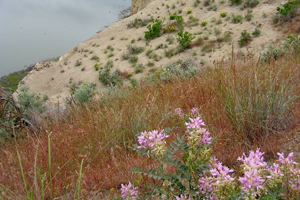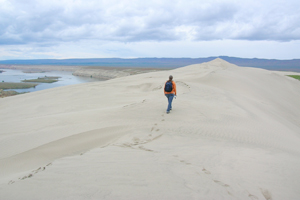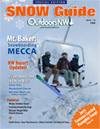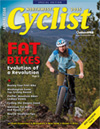NW Trails: Hiking the Hanford Reach National Monument Near Tri-Cities

Hiking Hanford Reach’s White Bluffs
From atomic bomb project to National Monument
Story and Photos by Craig Romano
Photo at right: Wildflowers add color to the white bluffs of Hanford Reach.
Towering white bluffs, massive sand dunes, pelican colonies, brilliant wildflowers, and the longest stretch of free-flowing non-tidal section of the Columbia River all help make the Hanford Reach one of the most dramatic natural areas in Washington state.
NW Trails is sponsored by:
Protected as a national monument, it surely would have been developed and farmed if not for the atomic bomb. Let me explain.
Back in 1943 while we were in the midst of World War II, the U.S. government launched the Manhattan Project; which would not only forever change the course of history with the birth of the atomic bomb, but also change the landscape of the lower Columbia River Basin.
 To facilitate the processing of plutonium, a large remote area was needed with an ample nearby power source. The federal government chose the Hanford Site, an area of over 428,000 acres mostly within Benton County. Two communities—Hanford and White Bluffs—were condemned and evacuated, and the little town of Richland was transformed into a government city of 25,000.
To facilitate the processing of plutonium, a large remote area was needed with an ample nearby power source. The federal government chose the Hanford Site, an area of over 428,000 acres mostly within Benton County. Two communities—Hanford and White Bluffs—were condemned and evacuated, and the little town of Richland was transformed into a government city of 25,000.
Operations at Hanford were expanded during the Cold War to ultimately include nine nuclear reactors and five plutonium processing complexes responsible for supplying the U.S. Nuclear weapons arsenal. As the Cold War dissipated, Hanford’s weapons production reactors were decommissioned leaving behind significant amounts of radioactive waste and contaminated groundwater.
Today the site is one of the nation’s largest Superfund cleanup areas. The site still hosts one nuclear power plant as well as numerous scientific research and development labs.
Large tracts of Natural Habitat
 Ironically, this massive government project with its large buffer zones ended up preserving large tracts of natural habitat—some of the last significant undeveloped sections of the Columbia Plateau’s sage steppe ecosystem.
Ironically, this massive government project with its large buffer zones ended up preserving large tracts of natural habitat—some of the last significant undeveloped sections of the Columbia Plateau’s sage steppe ecosystem.
In 2000 President Clinton invoked the Antiquities Act of 1906 (which President Teddy Roosevelt used to protect the Grand Canyon and other major natural sites) and proclaimed 195,000 acres of the buffer zone around the Hanford Site as a national monument. As well as containing rare plants, endemic species, elk herds, and over 250 species of birds, the monument also contains a 51-mile free-flowing stretch of the Columbia River.
The monument is managed by the U.S. Fish and Wildlife Service and 57,000 acres of it are open to the public including the White Bluffs which offer some amazing hiking. The bluffs are across the river from the

Watch for white pelicans below and swallows along the White Bluffs when hiking near the Hanford Reach.
Superfund site too, so exposure to radioactive waste is not an issue while hiking here.
Locust Trees Mark Trail
The unsigned and unofficial trail starts by a post near a grove of locust trees planted by early homesteaders. At first grassy and then more defined, follow the path up an open slope that dazzles with flowers in the spring. The impressive White Bluffs and Columbia River immediately come into view.
Watch for white pelicans below and swallows along the bluffs where they nest in profusion. The path can be sketchy, vanishing at times in dunes. Just work your way up and down along the bluff tops staying away from cliff edges.
Now continue higher onto the bluffs enjoying excellent views of Locke Island below, Rattlesnake Mountain to the west and Saddle Mountain north. At about two miles reach impressive dunes that may have you feeling like you’re in the Sahara. Walk across them continuing north.
From these sandy vantages over 300 feet above the river, take in commanding views of the shoreline below the bluffs. Scan it and the wetland pockets between the dunes for deer, coyotes, and jackrabbits. At 3.5 miles the dunes end.
While you can continue hiking another mile farther north, paths are practically non-existent and brush can be thick. Best to turn around here, but take your time on the return savoring views of the amazing natural world before you—reflecting upon incredible human history of this unique place.
(Editor’s Note: The Hanford Reach is one of the driest parts of the state with annual rainfall averaging a mere 7 inches. Because of its harsh, but fragile environment, tread softly while exploring it and be sure you are well-prepared with ample water and sun protection.)
Getting You on Your Way
Trip Details
Distance: 7 miles roundtrip with 500 feet of vertical elevation
Trailhead Directions: Follow I-90 east to Exit 137 and head south on SR 26 for one mile. Bear right onto SR 243 and after 14 miles turn left onto the 24SW Road. Follow for 13.7 miles to SR 24, turning left and continuing east for 10 miles to a turnoff right, just past Milepost 63. Continue on a gravel road south for 3.9 miles to a junction. Turn right and continue 1.3 miles to trailhead located on right before boat launch.
Notes: Gate closes at sunset; watch for rattlesnakes; pack water and sunscreen
Contacts
Hanford Reach National Monument, Mid-Columbia River National Wildlife Recreation Complex: www.fws.gov/refuge/Hanford_Reach/
Manhattan Project: inventors.about.com/od/astartinventions/a/atomic_bomb.htm
Craig Romano is Trails Editor of OutdoorsNW and is the author and co-author of 12 Northwest hiking guidebooks including Day Hiking Eastern Washington (The Mountaineers Books), which spotlights 125 hikes east of the Columbia River. Visit him at CraigRomano.com





